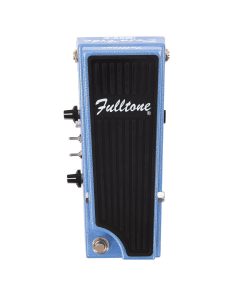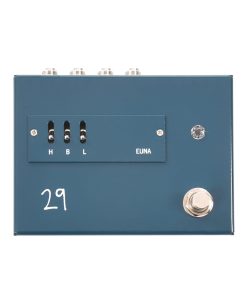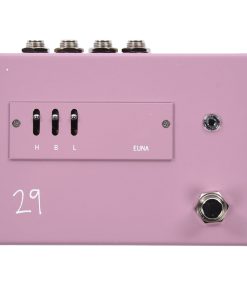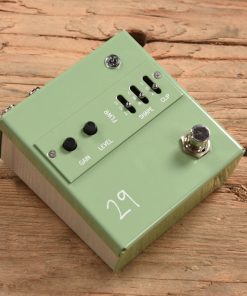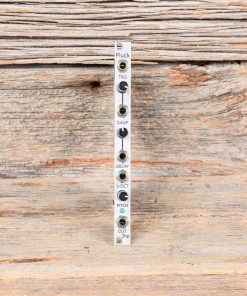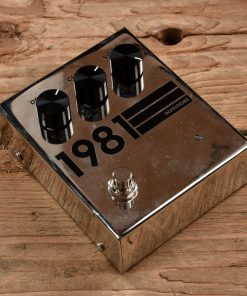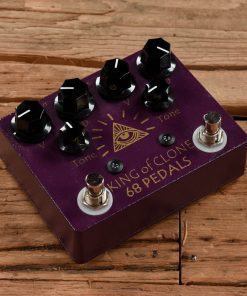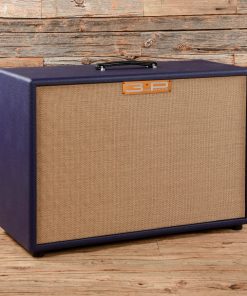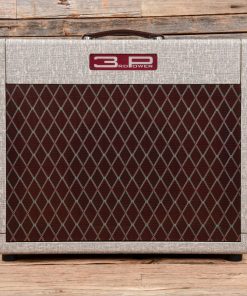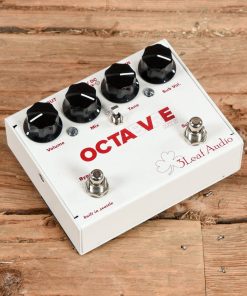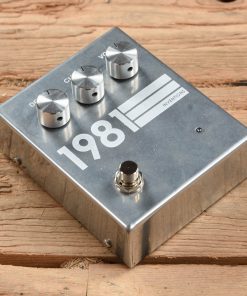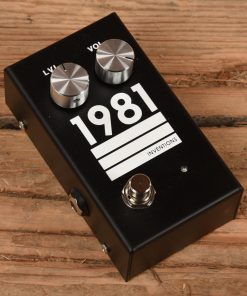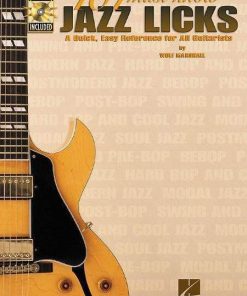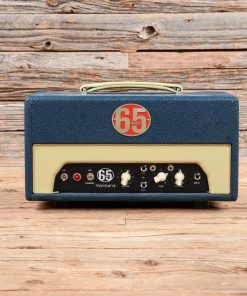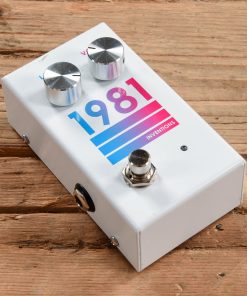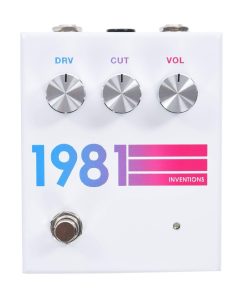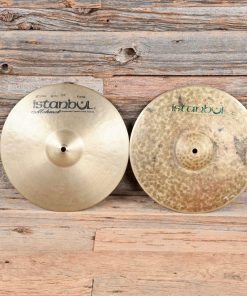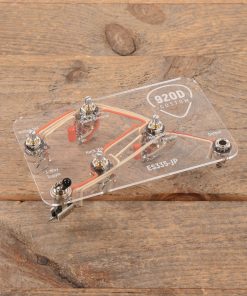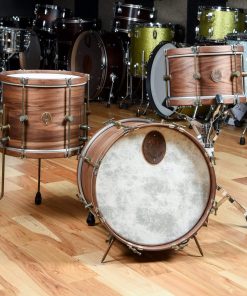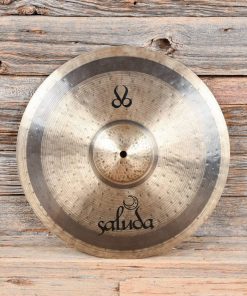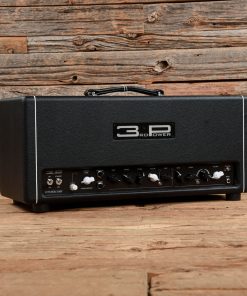Fulltone Custom Shop Mini Deja Vibe 3 Pedal Fulltone
$ 399,00 $ 119,70
Real Estate is precious, especially on your pedalboard, but the lush organic sounds of a perfect “authentic vintage Univibe clone” are a necessity, and they are now attainable in a space now smaller than a standard wah wah pedal… the Mini-Deja’Vibe3, MDV-3 for short. With a Hammertone Blue powder coated finish, White lettering, and a Blue LED that throbs to the beat of the pedal’s hypnotic, asymmetrical rhythm. The MDV-3 has a new heel or toe activated True-Bypass footswitch that is perfect for the person who rarely changes speeds and just wants to turn it on or off with his toe, but also perfect for the person who rides it like a Gas-pedal and wants to turn the pedal on/off with a simple flick of the heel (see the MDV-3 video at youtube/fulltoneeffects)
There are a LOT of pedals claiming to be “authentic vintage Univibe clones” on the market….all of the small ones are merely a glorified MXR phaser with a few changes. That’s not a Univibe! So how is one to know which pedals are real and which ones are just a cheap shortcut circuit that will satisfy you only until you get a chance to play pedal like the Fulltone MDV & MDV-3, both of which sport a “100% real vintage circuit.”
A real Univibe clone will have:
- 4 x glass covered/hermetically-sealed photocells and an incandescent bulb on the circuit board. I go one step further…and NO ONE else does this, I took many real 1960’s ‘cells and had them cloned for not only dark/bright resistance, but also cloned the all-important rise and fall times of the cells as they react to the light turning on and off. Nobody else even knows about this, let alone bothers with it. They just buy whatever off-the-shelf photocells they can get, oblivious to these specs. Yes, even those forum-worshipped wait-list builders.
- Run at 18+ volts.
- Totally discrete electronics, i.e. NO OPAMPS in the audio path! I go even further by only using New Old Stock (N.O.S) Panasonic Matsushita 2SC828 transistors for all stages, and the same metal-can 2SC539 transistor as original Univibes had for the preamp… this really makes a difference in the sound! You think those are cheap or easy to find?
In typical Fulltone fashion, I also manufacture my own speed potentiometer… it’s a dual pot with a gear on it like wah-wah pot, and with a special taper. (same as original Univibes) The only change made is I up’d the resistance to 200K to get you better slow speeds, and double screen the carbon composition track to last years beyond what the old ones lasted.
I’ve been building “authentic vintage Univibe clones” longer than anyone, since 1993. Mine are used by Robin Trower, Peter Frampton, Doyle Bramhall II, and countless others… by the people who know great sound and won’t settle for less.
Fast Shipping with Professional Packaging
We offer a wide range of shipping options due to our long-standing partnerships with UPS, FedEx and DHL. Our warehouse staff are trained to pack your goods exactly according to the specifications we offer. Before shipping the goods are thoroughly examined and secured. Every day, we send thousands of packages to clients from all over the world. Our determination to be the biggest online retailer in the world is shown by this. The warehouses are located in Europe as much as they are in USA.
Note: Orders with more than one product will be assigned a distinct processing time, dependent on the particular item.
Before shipping, we will examine the items ordered thoroughly before sending the items. The majority of orders are shipped within 48 hrs. The delivery estimate is between 3-7 days.
Returns
The stock is constantly changing and cannot be fully controlled by us because of the involvement of several parties including the factory and our warehouse. Stock levels can fluctuate at any given time. Please be aware that it is possible that your order could become unavailable even after you've placed your order.
Our policy is valid for a period of 30 days. If 30 days have passed by since your purchase however, we're unable to give an exchange or refund.
In order to be eligible for a refund your product must be unopened and in the same state as you received it. It should also be in the original package.
Related products
Effects and Pedals / Overdrive and Boost
Effects and Pedals / Overdrive and Boost
29 Pedals Special Run Crunch Berry EUNA Elite Unity Amplifier Input Driver 29 Pedals
Amps / Guitar Heads
Effects and Pedals / Overdrive and Boost
Keyboards and Synths / Synths / Eurorack
Accessories / Books and DVDs
Effects and Pedals / Overdrive and Boost
Parts / Amp Parts
920D Custom LP50-SPLIT Les Paul Wiring Harness Upgrade w/Coil Split Mod 920D Custom
Effects and Pedals / Overdrive and Boost
Amps / Guitar Cabinets
3rd Power Amplification 2×12″ Guitar Speaker Cab 3rd Power Amplification
Amps / Guitar Combos
3rd Power Amplification British Dream MKII 1×12 Combo 3rd Power Amplification
Effects and Pedals / Octave and Pitch
Effects and Pedals / Overdrive and Boost
Effects and Pedals / Overdrive and Boost
Parts / Amp Parts
920D Custom JB-CON-CH-BK Upgraded Replacement ’62 Jazz Bass Concentric Control Plate 920D Custom
Parts / Amp Parts
Accessories / Books and DVDs
Drums and Percussion / Acoustic Drums / Snare
A&F Drum Co. 1.75×12 Pancake Raw Brass Snare Drum A&F Drum Co.
Amps / Guitar Heads
Effects and Pedals / Overdrive and Boost
Effects and Pedals / Overdrive and Boost
1981 Inventions DRV Overdrive White Hyperfade 1981 Inventions
Drums and Percussion
20″ Craig Lauritsen Custom Rustico Crash Ride Cymbal USED Chicago Music Exchange
Effects and Pedals / Wahs and Filters
Drums and Percussion / Cymbals / Hi-Hats
Accessories / Merchandise
Drums and Percussion / Acoustic Drums / Full Acoustic Kits
Accessories / Books and DVDs
Parts / Amp Parts
920D Custom ES335-JP Wiring Harness for Gibson/Epiphone ES-335 w/Four Push/Pulls 920D Custom
Drums and Percussion / Acoustic Drums / Full Acoustic Kits
A&F Drum Co. 12/14/18 3pc. Walnut Club Drum Kit A&F Drum Co.
Effects and Pedals / Overdrive and Boost
1981 Inventions DRV Overdrive Black Hyperfade 1981 Inventions
Drums and Percussion / Cymbals / Crash
Amps / Guitar Cabinets
3rd Power Amplification Kitchen Sink Guitar Head 3rd Power Amplification


